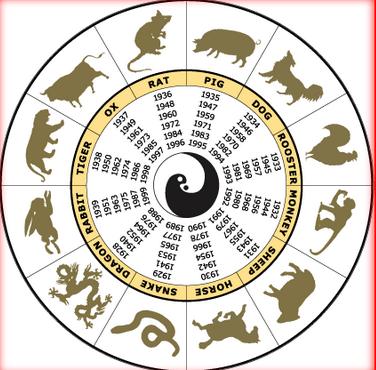Login form
Vietnamese Zodiac
 In Vietnam, the calendar was devised based on the regularly changing phases of the moon. Most Vietnamese, even city dwellers and overseas Vietnamese, have a lunar calendar in their homes to consult for festivals and auspicious dates. Because of the use of the lunar calendar, the actual days of the New Year vary from year to year.
In Vietnam, the calendar was devised based on the regularly changing phases of the moon. Most Vietnamese, even city dwellers and overseas Vietnamese, have a lunar calendar in their homes to consult for festivals and auspicious dates. Because of the use of the lunar calendar, the actual days of the New Year vary from year to year.
The equinoxes and solstices that marked the beginning of the European seasons were taken as the midpoint by the Asian calendar with the result that each Vietnamese season begins six weeks earlier than its European counterpart.
Each year is "sponsored" sequentially by one of the twelve animals of the Vietnamese zodiac: the rat comes first, then the buffalo or ox, followed in order by the tiger, cat, dragon, snake, horse, goat, monkey, cock, dog, and lastly, the pig.
Of these animals one is mythical (the dragon) and four (rat, tiger, snake and monkey) are wild, shunning contact with humans. Seven are domesticated. Every twelve years, the sponsorship reverts to the same animal. For example, the years 1976, 1988, 2000, 2012 are dragon years.
In addition the Vietnamese use another set of names by repeating a cycle of 60. The 60-year cycle is made up of combinations of the twelve animals representing the earthly signs of the Vietnamese zodiac and ten heavenly or celestial signs usually called "stems". The Asian calendar forms a cycle of 60 years similar to the western century of one hundred years. The 60-year cycle begins when the first of the twelve zodiac signs is joined with the first of the ten celestial "stems". When each of the ten "stems" is matched with an animal, the result will be 60 different sets. The celestial "stem" attached to the zodiac animal provides modifying influences on the characteristics of the animal. For example, the year of the dog sign can be "modified" by each of ten different associated "stems".
Enjoy the Tet with our exciting predictions of your future. And after reading your animal sign, please believe in good things and forget bad ones.
- Prev
- Next >>

